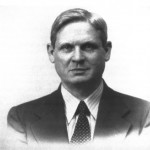
Kleitman, Nathaniel
Kleitman had studied with the French physiologist Henri Pieron in Paris. His aim was to gain a thorough understanding of sleep at a physiological level.
 |
After studying with Henri Pieron, Kleitman had sought to provide a thorough physiological description of sleep. His 1939 book and its 1963 update constitute an encyclopaedic compendium whose bibliographic thoroughness has never since been imitated. (Sleep and Wakefulness)
Nathaniel Kleitman |
It was probably the combination of innocence and ambition of the younger investigator, Aserinsky, and the wisdom of the experienced and older investigator, Kleitman, that led to the key observation-and its correct interpretation. In graduate school, Aserinsky was interested in studying attention in children. While making clinical observations of his young subjects’ efforts to attend, he noticed that eye closure was associated with attentional lapses, and therefore decided to record these eyelid movements using the electrooculogram (EOG). In order to obtain a more complete picture of the attentional state of his subjects, he also recorded brain-wave activity. This combination of measures was propitious because, unlike adults, children often enter the REM phase immediately at sleep onset; and these sleep-onset REM periods are especially likely to occur during daytime naps. When Aserinsky’s subjects lost attentional focus and fell asleep, their EEGs showed an activation pattern and their electrooculograms showed rapid eye movements. Kleitman quickly deduced that this brain-activated sleep state, with its rapid eye movements, might be associated with dreaming. The two investigators immediately applied the combined EEC and EOG measures to the sleep of adult humans and were able to observe the periodic alternation of REM and non-REM sleep throughout the night. And the awakenings that they performed during REM sleep yielded accounts of dreams.
In 1953, Aserinsky and Kleitman reported their findings in Science. like many really important articles, this one was short and to the point. It even included the observation that other physiological functions change with the state of the brain-mind: respiratory frequency and heart rate had both been noted as increasing; and their rhythm became irregular. Aserinsky and Kleitman provided more systematic observations of this ‘Phase of Ocular Motility Occurring in Sleep’ in the Journal of Applied Physiology’ in 1955.
William Dement confirmed Aserinsky and Kleitman’s hypothesis that these periods of brain activation during sleep are highly correlated with dreaming. When normal subjects were aroused from REM sleep, they gave detailed reports of dream activity. The capacity to recall dreams appeared to be related to the nature of the awakening process; subjects who learned to reach a fully aroused mental state without moving greatly increased their recall capacity. Within the REM period, dream intensity tended to parallel the intensity of phasic physiological events, especially the clusters of rapid eye movements; arousal during REM sleep with eye movement activity yielded reports fulfilling the definition of dreaming given here in 90 to 95 percent of the cases. When scored for vividness, emotionality, and imagined physical activity, these psychological measures also correlated positively with the quantitative intensity of the eye movement in the REM sleep just prior to awakening.
In 1952, Eugene Aserinsky was preparing his report (with Nathaniel Kleitman) for the journal Science on the discovery of REM sleep and its correlation with dreaming. Here is his own description of the origin and meaning of this photograph: ‘The entire sleep research up to the mid-60s alone. Interestingly enough, after devoting four or five decades to sleep research, after publishing about a hundred papers himself and after (presumably) having read at least 4,237 other papers, Kleitman himself holds to a view of sleep that is diametrically opposed to almost everybody else’s. In his view one has to look upon sleep as the physiologically natural state and wakefulness as a special kind of deviation from the norm. The central nervous system, he believes, is basically a dormant, unsensing, non-learning, disinterested device which gets slammed into periodic activity by physical pressures of one kind or another, such as the need to feed, mate, find a protective den and so on. Once these have been achieved the brain sinks gratefully back into its vegetative oblivion. To be fair, it should be pointed out that Kleitman is not arguing that the least important phase of existence is wakefulness, but simply that sleep is the natural, basic state rather than the other way round, as everybody else assumes. Consequently, what one should really be looking for are theories of wakefulness instead of theories of sleep. See: Aserinsky E.